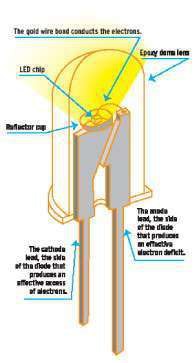Cool Energy
LEDs are popular on show trucks such as Disorderly Conduct, Paul Voigt’s 1999 Peterbilt 379.
In the last two decades, light-emitting diodes have become as much a staple for over-the-road trucks as CBs. And for good reason.
 LEDs are popular on show trucks such as Disorderly Conduct, Paul Voigt’s 1999 Peterbilt 379.
LEDs are popular on show trucks such as Disorderly Conduct, Paul Voigt’s 1999 Peterbilt 379.LEDs last at least 10 times as long as incandescent bulbs and use much less energy. They give off virtually no heat. They’re easy to install. Since LEDs don’t use a filament, they are impervious to shock and vibration, says Tom Draper, Grote Industries marketing director.
Their truck usage has grown since 1989, when Grote Industries developed brake, turn and indicator lights. Now white LED truck headlights are entering the market.
On-board lighting
 When a voltage is applied, electrons cross over from the cathode to the anode and produce light. Unlike incandescent bulbs, which produce a wide range of light frequencies, most of them invisible, LEDs can be engineered to produce light in specific frequencies, which we see as colors.
When a voltage is applied, electrons cross over from the cathode to the anode and produce light. Unlike incandescent bulbs, which produce a wide range of light frequencies, most of them invisible, LEDs can be engineered to produce light in specific frequencies, which we see as colors.Truckers who rode the highways using high-powered LEDs when they emerged in the mid-1990s were soon joined by those riding the waves. The Night Stalker surfboard featured LED side fins, Popular Mechanics reports: “Sure, surfing at night is still dangerous, but at least you’ll never be mistaken for a seal.”
POINT OF LIGHT
The crux of the LED is a chip that’s no bigger than a square millimeter, the size of a pencil point. It’s made of sapphire wafers with deposits of compounds of familiar elements such as aluminum and nitrogen, and more unusual ones, such as gallium and indium.
SAPPHIRE
Sapphire’s glitz might be why the world’s largest strip club, in Las Vegas, bears that name, but the gemstone’s durability and hardness are why it’s used in minuscule amounts in the LED chip. The precious blue rock is also used in fiber optics and lasers for the same reasons.
GALLIUM
The soft, blue-white metal also is used in microwaves, transistors, semiconductors and high-temperature thermometers. Gallium has one of the largest liquid ranges of any metal, but you don’t want to quench your thirst with it.
INDIUM
This relatively rare metal is used to make other light-related products, including LCDs and flat-screen TVs. It’s extremely soft, and has replaced highly toxic mercury in thermometers.
— Philip Coulter contributed to this report.








